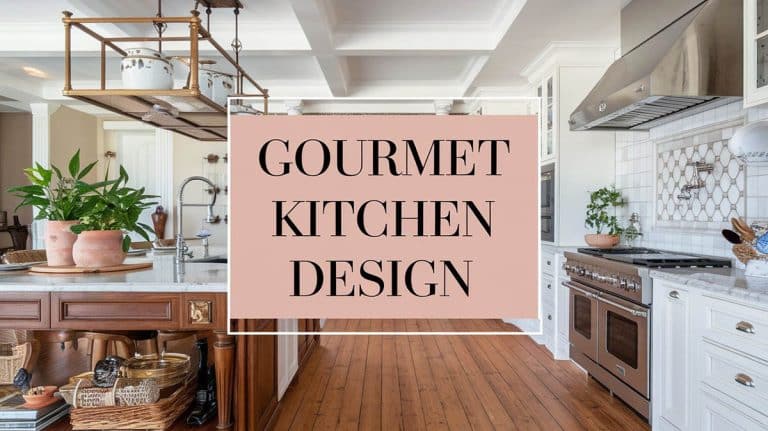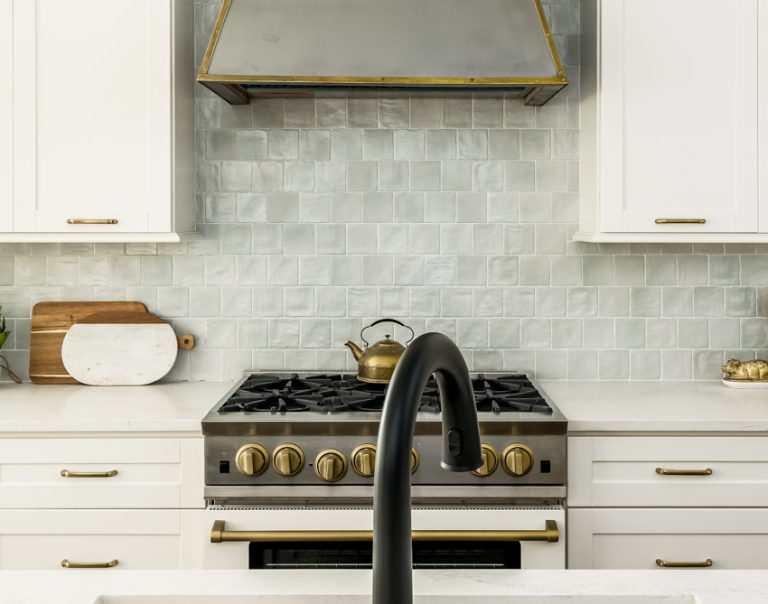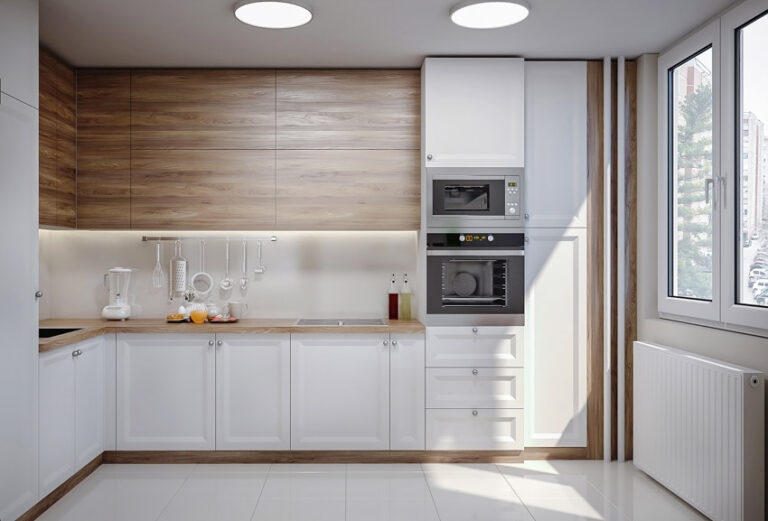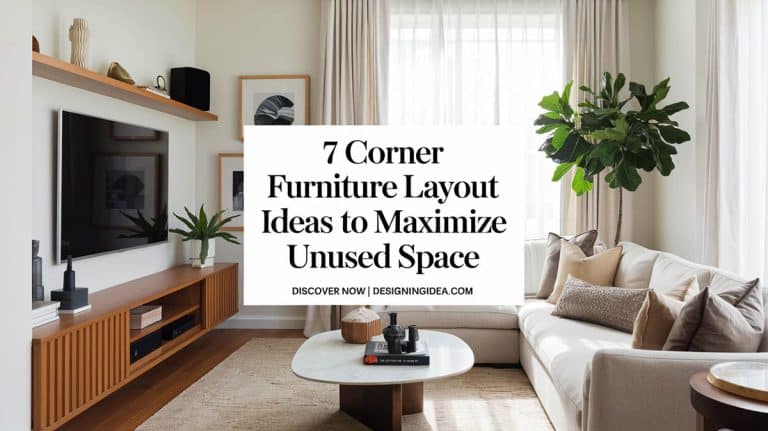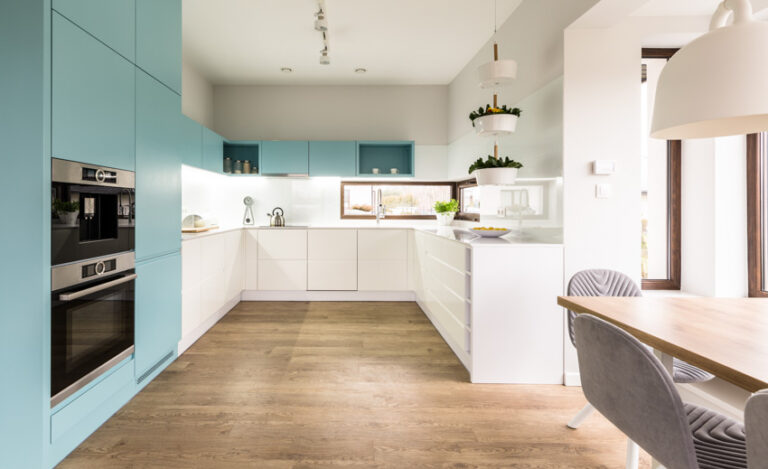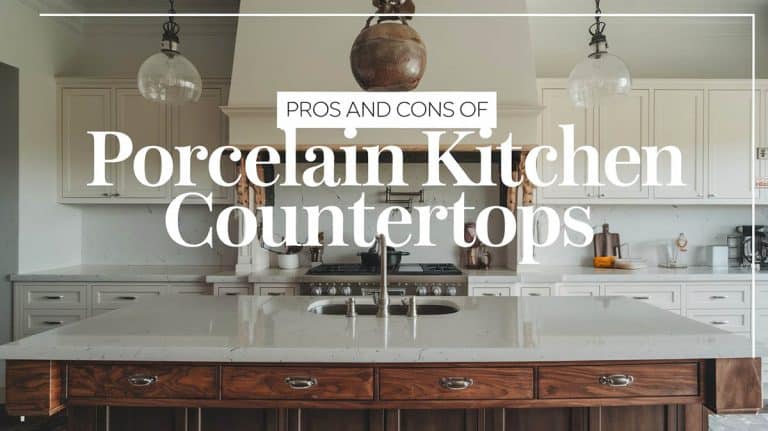7 Open Concept Kitchen and Dining Room Layouts That Flow Beautifully
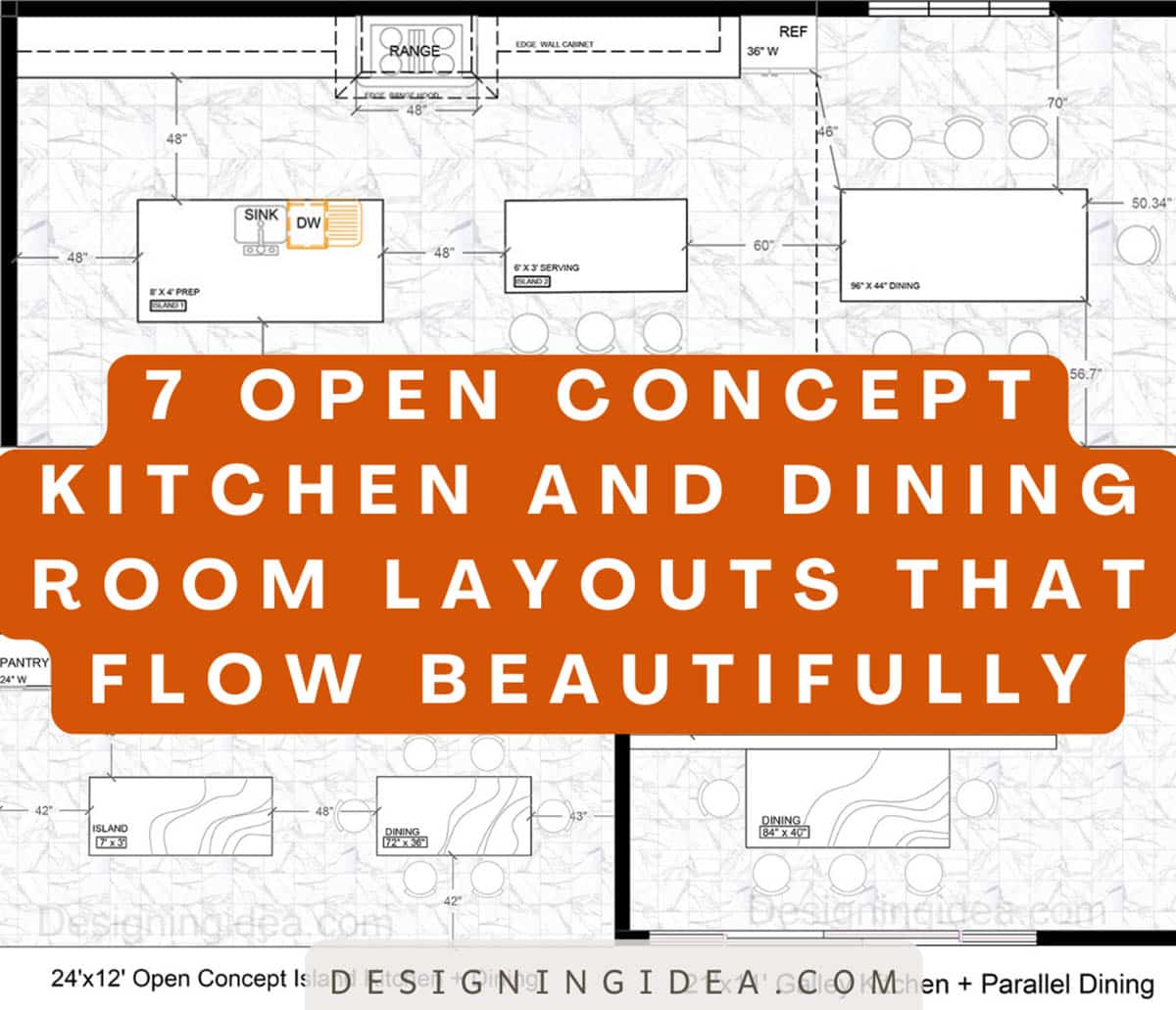
Designing for an open-concept space where the kitchen and dining room work together takes careful planning to create a functional and inviting floor plan. Whether you’re cooking for family or ensuring there’s enough room for entertaining guests, a well-planned room is a necessity. This article explores seven open concept kitchen and dining room layouts that flow beautifully, with each one offering balanced proportions and effortless transitions between prepping, serving, and gathering.
24×12 Open‑Concept Kitchen Island And Dining Table Layout
This open-concept island-and-dining layout is perfect for when you want an uninterrupted cooking-to-entertaining floor plan that is spacious and stylish, and still provides all the necessities within easy reach.
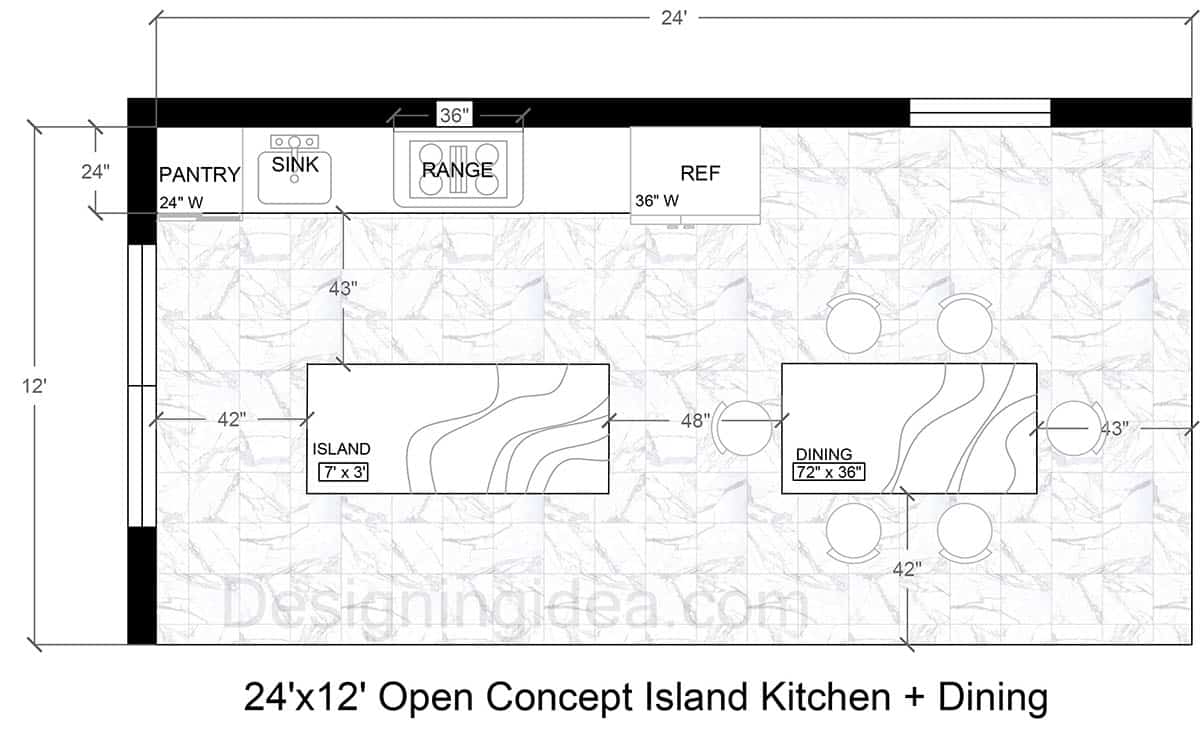
Floor Plan Details: A single wall houses all of the essential appliances for this open-concept kitchen with a central island and a dedicated dining zone. Moving from left to right, you’ll find a 24-inch pantry cabinet that flows into the sink, prep counter, 36-inch range, and ends with a 36-inch refrigerator. Across from the main countertops sits a useful 7′ × 3′ island that is positioned roughly one-third of the way across the room. The island can be used for additional storage, prep surface, or eat-in dining. Moving past the island to the right sits a 72″ × 36″ dining table that can comfortably seat up to six. The table is aligned horizontally with the island so sight-lines stay clear and conversations can flow between cooks and their guests.
Dimensions:
- Room size: 24′ (L) × 12′ (W)
- Base kitchen run: Approx. 10′ of counter between pantry and fridge (24″ pantry + 24″ sink base + 36″ range cabinet + 36″ fridge opening)
- Island: 7′ × 3′ (84″ × 36″)
- Aisle to wall cabinets: 43″
- Aisle to dining table: 48″
- Dining table: 72″ × 36″ (seats 6)
- Clearance to right-hand wall: 43″
- Clearance to bottom walkway: 42″
- Side entry/exit clearance (left of island): 42″
Design Tips:
- Keep plumbing & ventilation simple. A single-wall layout means all electrical/plumbing services line up along one exterior wall, reducing cost and complexity.
- Use the island as a command center. Add deep drawers for small appliances, pots, a pull-out trash, and pendant lighting to create a true prep zone with the range and sink nearby.
- Use contrasting finishes. A darker island base or waterfall countertop can add charm to the long room and act as a focal point.
- Define zones with lighting. Pendants over the island and a statement chandelier over the table bring focus to the different cooking and dining zones.
- Plan for traffic flow. The 48-inch gap between the island and the table is wide enough for two people to pass, which is important in a busy household.
- Consider having storage near the dining. A low sideboard, console or built-in bench along the right wall can hold table linens or other essential without clogging the kitchen.
Best for: Families who entertain and need ample prep space plus seating for 6 to 8.
18×14 L‑Shaped Kitchen Floor Plan with Bay‑Window Dining Nook
This L-shaped kitchen combined with a bay-window dining nook offers a bright and sunny eating corner, and a relaxed, family-friendly flow.
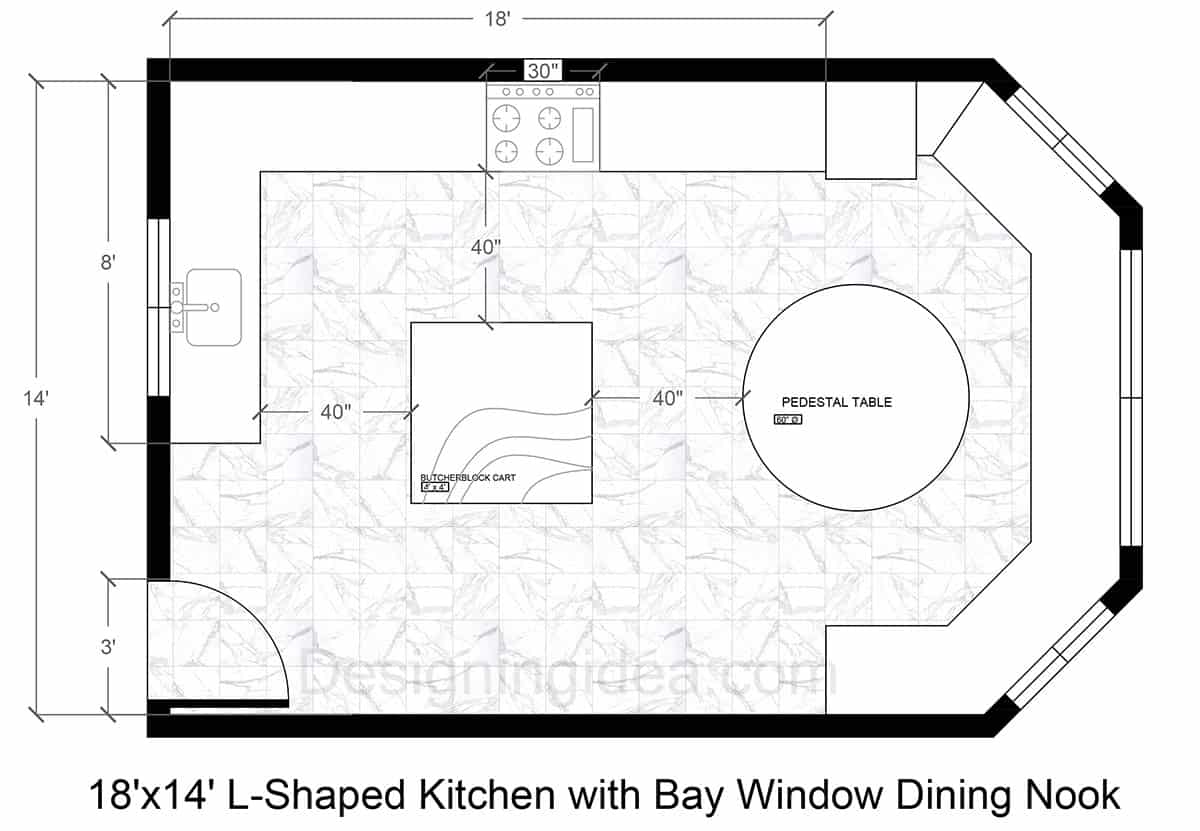
Floor Plan Details: This L-shaped kitchen positions its base and wall cabinets along the left-hand corner, with the sink on the short leg and the 30-inch range in the center of the long leg, with an abundance of counter space on either side. An inviting bay window is located on the right wall and becomes a light-filled dining nook paired with a 60-inch round pedestal table for a bright and cheery place for friends and family. The middle of the room has a portable 4′ × 4′ butcher-block cart that acts as a mobile island and provides extra prep space and a large 40 inches of aisle on all sides. The main entry door is found at the bottom left, and there’s uninterrupted floor space that funnels foot traffic directly to either the prep area or the sunny breakfast corner without interfering with the cooking area.
Dimensions:
- Room size: 18′ (W) × 14′ (D)
- Left-leg run: 8′ of base/wall cabinets with the sink placed under a window
- Back-wall run: 18′ of continuous counter, a 30″ range, fridge location left open for flexibility
- Mobile island/cart: 4′ × 4′ (48″ × 48″) with 40″ clearances on all sides for ease of movement
- Dining table: 60″ diameter round, pedestal table at the bay window
- Clearance from cart to table: 40″
- Primary work aisles (sink ↔ range, range ↔ cart): 40″
- Entry door width: 3′ swing-in
Design Tips:
- Use the bay window as a gathering spot. A round table plus banquette cushions can turn the nook into a morning coffee hotspot bathed in sunlight.
- Keep the cart mobile. Locking casters let you roll it against a wall when you need the space, or pull it beside the range for extra landing space when prepping or cooking.
- Zone lighting. A pendant or track lighting over the cart, combined with a statement fixture in the bay, can help define tasks and emphasize the architectural angles.
- Maintain the 40-inch rule. This clearance comfortably accommodates two cooks passing while still feeling intimate.
- Contrast finishes for balance. A butcher-block top on the cart and a painted base can offset the perimeter counters and warm up any darker elements.
Best for: Compact homes needing a cozy eat‑in spot without a separate dining room, and households with families.
21×11 Galley Kitchen With Parallel Dining Layout
Choose a galley-plus-parallel-dining plan for an efficient one-wall work zone with separation, a long floor-to-ceiling storage cabinet, and a light-filled dining area that flows straight to the patio for outdoor meals and easy entertaining.
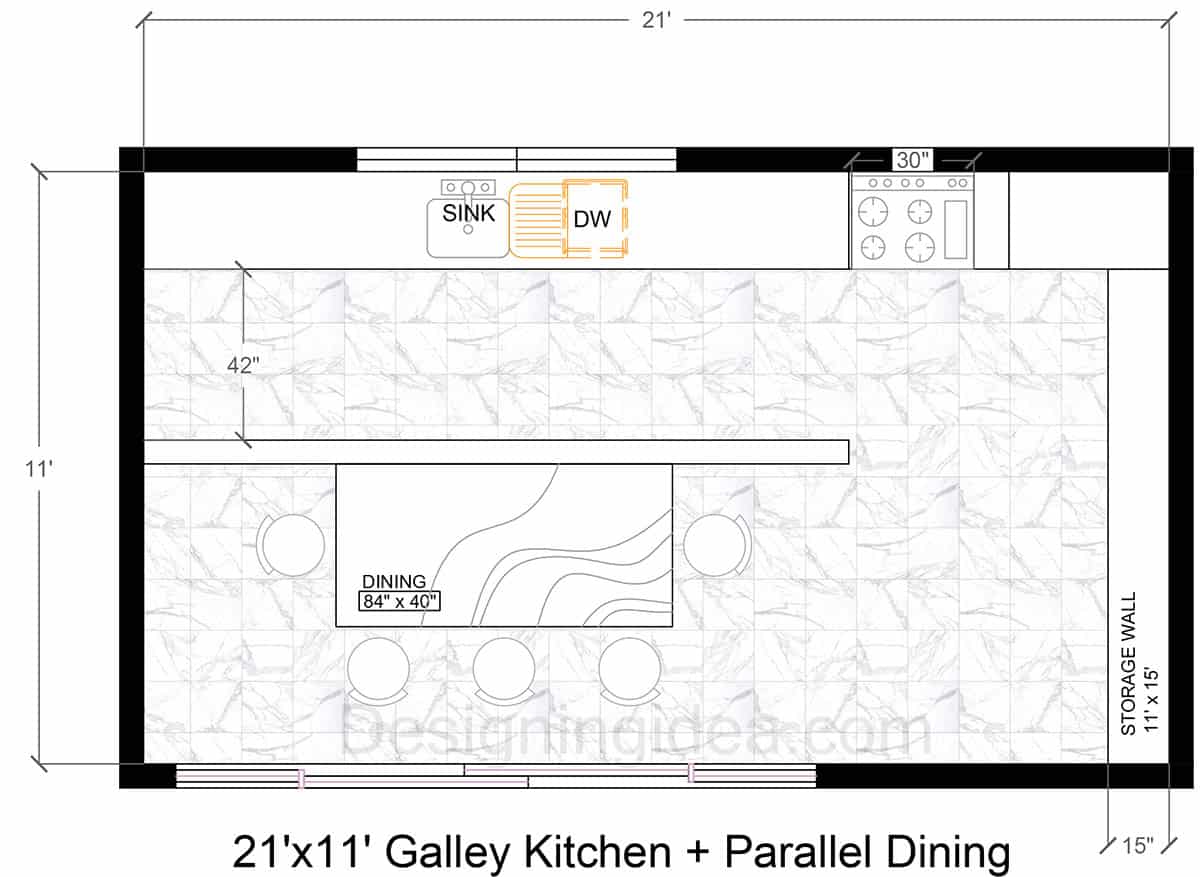
Floor Plan Details: This galley arrangement places every major appliance and sink along the north wall, with the space separated from the dining area by a wall. The prep line runs left-to-right from continuous counter space to a double bowl sink with a 24-inch dishwasher beside it, then finishes with a 30-inch range and landing counter. Forty-two inches of clear aisle separates the cabinets from the wall to provide room for the cook’s path. On the other side, a large 84″ × 40″ table seats six. The entire right wall is fitted with floor-to-ceiling cabinetry only 15″ deep, adding pantry and small-appliance storage while maintaining open circulation. Patio sliders on the lower wall flood the dining zones with natural light and create an easy indoor-outdoor flow.
Dimensions:
- Room size: 21′ (L) × 11′ (W)
- Primary cabinet run: full 21′ wall; 30″ range + 24″ DW + sink centered in run
- Work aisle width: 42″ between base cabinets and dividing wall
- Dining table: 84″ × 40″ (seats 6)
- Storage wall: 11′ length × 15″ depth (tall pantry/utility units)
- Lower wall openings: Sliding or French doors for daylight and patio access
Design Tips:
- Replace part of the dividing wall. If not fully load bearing, replace part or all of the wall with a 12″ wide ledge as a multitasker. Add a stone cap to turn it into a handy pass-through, snack bar, or homework spot without the bulk of a full island.
- Keep sight-lines open. In the galley, stick to under-counter appliances and low-profile hood options so the long wall feels more uninterrupted.
- Balance traffic. With doors along the bottom, place the dining table in the center and against the wall so chair movement stays clear of the sliders.
- Light in layers. Linear pendants or chandelier above the table, under-cabinet LEDs, and recessed lighting on the cook line, give each zone task-appropriate lighting.
- Exploit the 15″ storage depth. Pull-out trays, baking-sheet slots, or a coffee pantry fit in shallow cabinets without taking up valuable floor area.
Best for: Older loft or row‑house layouts with a closed kitchen where width is limited but length is generous
12×22 U‑Shaped Kitchen With Peninsula And Formal Dining
A U-shaped kitchen with a peninsula and dining area offers an effective chef-friendly workspace, a multifunction breakfast bar for impromptu meals, and a true sit-down table.
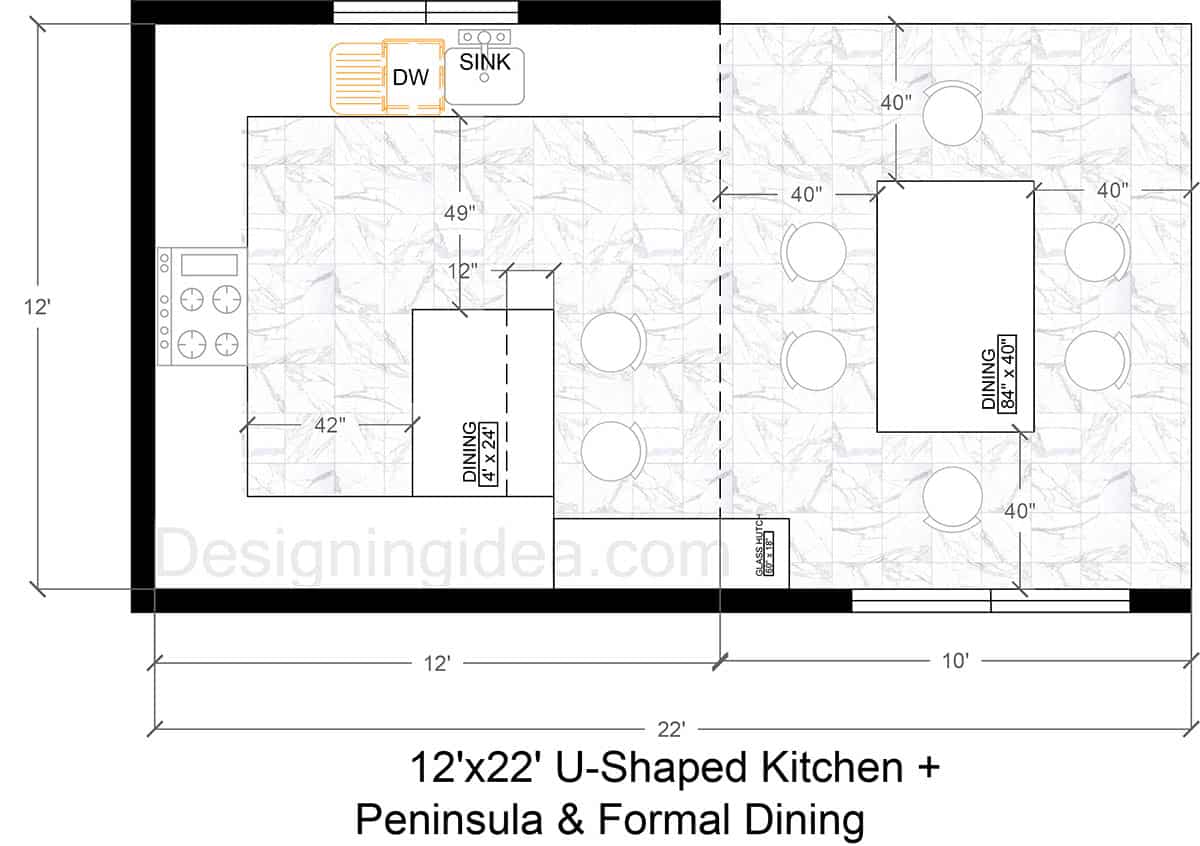
Floor Plan Details: A U-shaped kitchen layout with a peninsula is a very productive setup that surrounds the cook on three sides with counter space and offers the ability for eat-in dining. The left side offers a 12-foot module and wraps around to form a classic U. The 30-inch range anchors the shorter left wall; the top wall holds a double-bowl sink next to a dishwasher, while the right leg stops short to let a 4′-long × 24″-deep peninsula project up in front of the dining zone. That peninsula doubles as a two-seat breakfast bar and a landing spot for dishes. There’s a significant 49-inch passage between the peninsula and the sink run and a 42-inch aisle at the range, which is useful for two cooks to pass and work together. Beyond a dashed “traffic corridor” lies a formal dining area with an 84″ × 40″ table with eight chairs that enjoys equal 40-inch clearances on every side. Nearby sits a slim 60″ × 18″ glass-front hutch that’s tucked against the lower wall for serving pieces. The plan cleanly separates noisy prep from sit-down meals while letting food flow across the peninsula into the dining space.
Dimensions:
- Room size: 12′ (W) × 22′ (L)
- Kitchen zone: 12′ × 12′ U-shape
- Range wall depth to peninsula: 42″ aisle
- Sink wall depth to peninsula: 49″ aisle
- Peninsula size: 4′-0″ L × 24″ D (12″ overhang for seating at the counter)
- Formal dining zone: 10′-long section at right end
- Table: 84″ L × 40″ W (seats 6 to 8)
- Clearance around table: 40″ on all four sides
- Glass hutch: 60″ W × 18″ D, aligned with the bottom wall
- Appliance placements:
- 30″ range on left leg
- 24″ dishwasher directly right of sink on back wall
Design Tips:
- Use the peninsula as a pivot. Use waterfall ends or a contrasting finish to mark the hand-off point between the casual breakfast bar and the formal dining.
- Double aisles for double efficiency. The 49″ and 42″ corridors surpass the NKBA minimums, so two people can prep without collisions.
- Layered storage. Use a tall, shallow (18″-deep) hutch to keep china out of the cooking zone but within arm’s reach of the table.
- Lighting needs. Pendants over the peninsula, under-cabinet LEDs in the U, and a statement chandelier over the dining table create zones for lighting.
- Flooring continuity. Run the same tile or wood throughout to unify the spaces and make the 12′-wide room feel broader.
- Best for: This design defines a functional cook zone from the dining area and its comfortable seating.
24×13 One Wall Kitchen With Island Layout And Dining Area
Choose this one-wall kitchen with a 7-foot island for a service-efficient cooking area, paired with generous seating and an open dining zone.
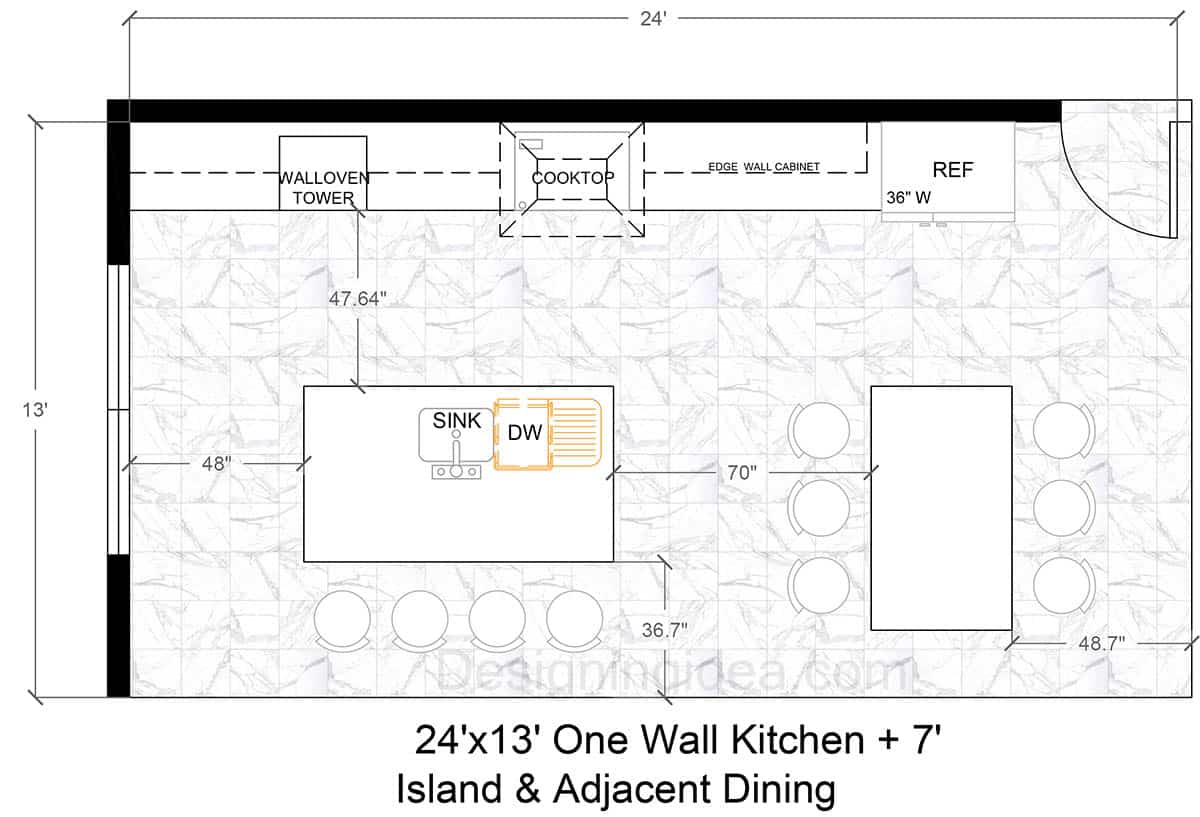
Floor Plan Details: Set inside this wide rectangular space, the one wall kitchen layout lines every appliance and cabinet along the upper side with the wall-oven tower on the far left, a centered 30-inch cooktop, and a 36-inch refrigerator beside the entry door. A 7-foot-long island is placed 48″ in front of the single-line run, and contains the main sink and a dishwasher, and room for four bar stools on the outer edge. Beyond the island, to the right sits a full-size dining table that can accommodate six diners. Thanks to the one-wall layout, the island forms an efficient parallel prep zone, and diners can sit nearby without interfering with the cook’s 48-inch work aisle.
Dimensions:
- Room size: 24′ (L) × 13′ (W)
- One-wall run: nearly 24′ continuous counter
- 30″ cooktop centered
- 36″ refrigerator at right end
- Wall-oven tower at left end
- Island: 7′-0″ L × 3′, 6″ D
- Work aisle to wall cabinets: 48″ (47.6″)
- Social aisle to dining table: 70″
- Seating overhang: fits 4 stools
- Walkway behind stools (to bottom wall): 36.7″
- Dining table footprint: seats 6 with a 48″ clearance to right wall and 70″ to island stools
- Left-side passage (entry zone): 48″ width
Design Tips:
- Cluster tall units. Flank the cooktop with a wall-oven tower, and the refrigerator at either end to balance the wall visually and keep the bulky masses at the sides.
- Use the island as a “prep” hub. With the sink and DW in the island, prep work flows straight to the cooktop.
- Mind the 48″/70″ clearances. These extra-wide aisles exceed NKBA guidelines, so multiple helpers or party guests can move freely without crowding.
- Seamless entertaining. The 7′ island overhang and adjacent dining table create two conversation zones only steps apart and are perfect for family conversations or casual breakfasts.
- Light layering. Hang a trio of pendants over the island, under-cabinet strips on the one-wall run, and a chandelier or linear fixture over the table to give each zone task-appropriate illumination while tying them together.
- Keep upper cabinets to a minimum. Consider using open shelving or glass-front cabinets above the cooktop to lighten the long wall instead of bulky upper units.
Best for: It works well for great modern rooms where prep, casual bites, and entertaining flow are all contained in one line.
16×16 Eat‑In L-Shaped Kitchen With Round Nook And 12×16 Formal Dining Room
An L-shaped kitchen with a small eat-in peninsula works for informal meals side-by-side with a formal dining area for everyday family meals and elegant entertaining.
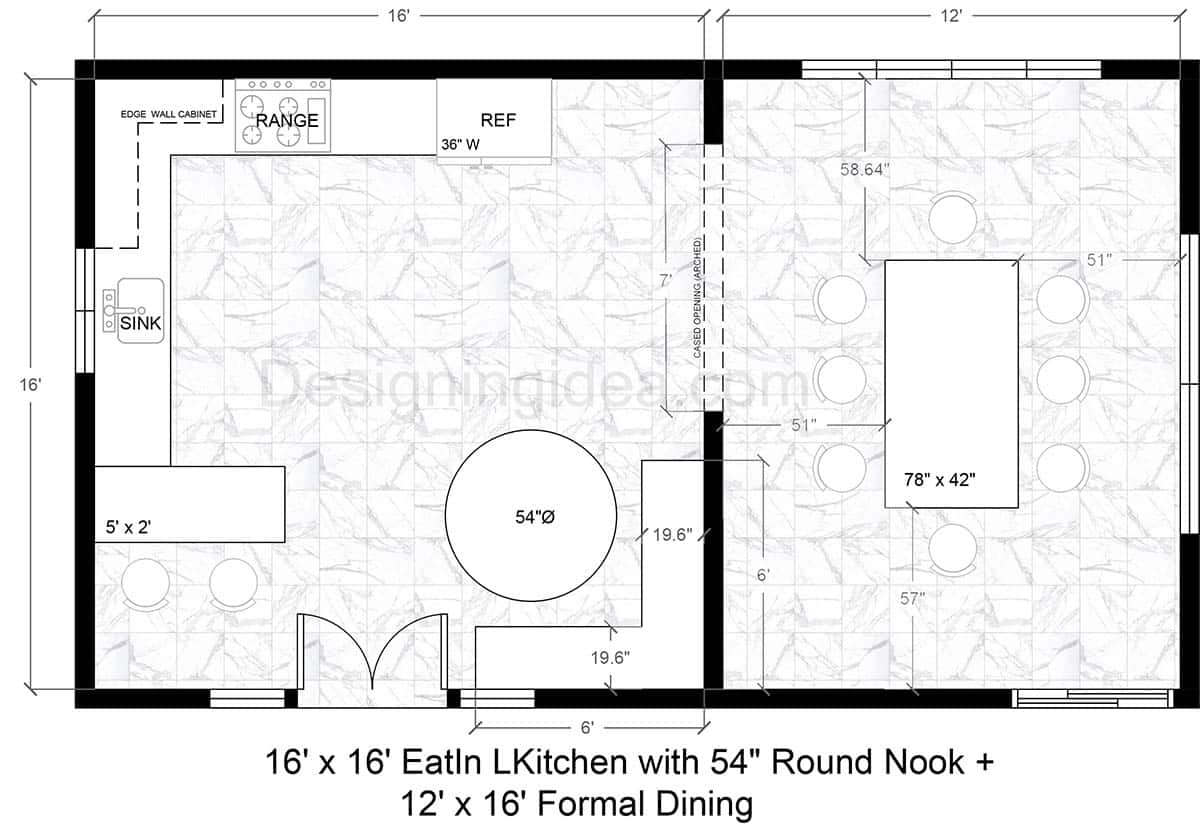
Floor Plan Details: This two-room scheme pairs an L-shaped kitchen with an adjacent formal dining room, linked by a 7-foot-wide cased opening that keeps sight-lines open, yet clearly separates functions. In the kitchen the cabinets trace the left and back walls forming an L-shape. A 30-inch range occupies the center of the top run, and a 36-inch refrigerator caps the far right end for easy accessibility. The sink sits on the short left leg beneath a window, and creates an efficient work triangle with the range and fridge. A 5′ × 2′ peninsula can be used to pull up two stools for eat-in dining. Nearby a 54-inch round table forms a casual “eat-in” nook with a built-in bench Step through the wide opening between the spaces, and you enter the formal dining room, where a 78″ × 42″ table for eight enjoys plenty of walking space on all sides and a broad window along the upper wall for natural light and outdoor views.
Dimensions:
- Kitchen footprint: 16′ × 16′
- Left leg length: 16′ (sink centered)
- Top leg length: 16′ (range & fridge)
- Peninsula: 5′ L × 2′ D with a 2-seat overhang
- Casual nook: 54″-diameter round table
- Clearance to walls/peninsula: 48″ all around
- Opening to dining room: 7′-0″ wide cased opening (no door)
- Work-triangle legs:
-
- Sink → Range 8′
- Range → Fridge 4′-6″
- Fridge → Sink 10′
-
- Formal dining footprint: 12′ × 16′
- Table: 78″ L × 42″ W (seats 6–8)
- Clearances: 59″ behind head chairs, 51″ on long sides, 57″ at foot end
- Passage beside peninsula to dining entry: 6′-0″ wide with 19.6″ knee-wall returns for visual separation
Design Tips:
- Dual-dining flexibility. Use the round nook table for informal breakfast and lunch and reserve the separate dining room for holidays or larger gatherings.
- Anchor the peninsula. Use a contrasting base color or waterfall edge to show the kitchen boundary and offer a handy serving spot.
- Layer the light sources. A pendant over the round table, recessed fixtures on the overhead, and a statement chandelier above the dining table.
- Consistent flooring. Run the same tile or wood through both rooms to visually stretch their width.
Best for: Everyday living with casual breakfasts and lunching in the nook, and dinner and special events in the attached dining room.
26×14 Dual‑Island Gourmet Kitchen Floor Plan With Dining Table
Choosing a dual-island layout with a dining table provides true chef-grade efficiency. The prep, serving, and dining areas are clearly separated, but function together for a cohesive design.
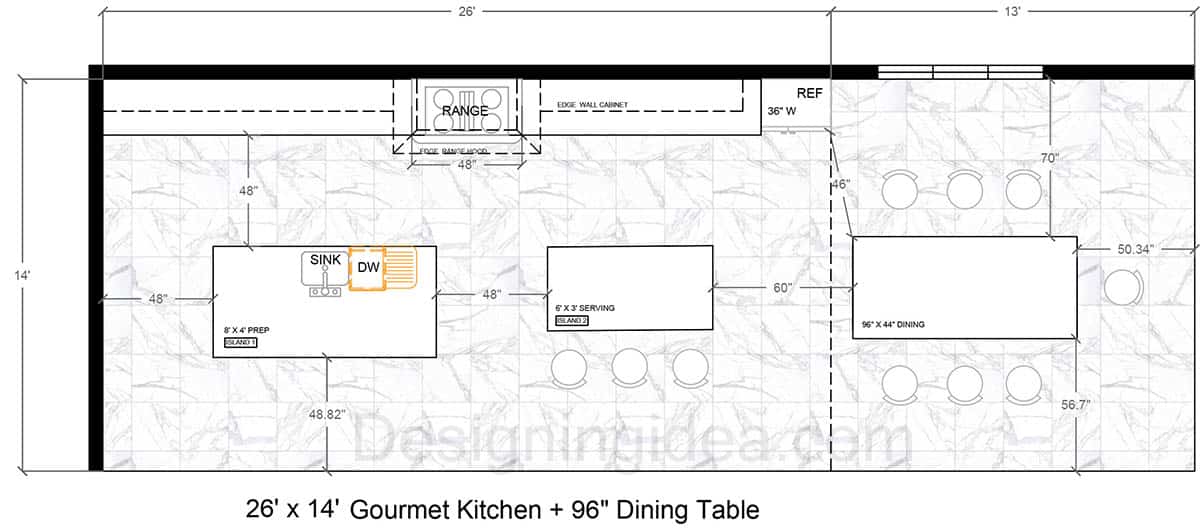
Floor Plan Details: This gourmet kitchen concentrates all tall storage and cooking power along the upper wall with dual island surfaces for meal prep, serving, and eat-in dining, combined with a large table for more formal dining. Along the kitchen’s back wall sits a 30-inch pro range, flanked by 48 inches of countertop landing space on either side, leading to a 36-inch refrigerator on the right end. Across on the left side is an 8′ × 4′ prep island, equipped with the primary sink and a dishwasher. Forty-eight inches farther on the right, a second 6′ × 3′ serving island provides buffet space and a three-stool breakfast ledge, for entertaining and quick meals. Further along sits a 96″ × 44″ table for eight with wide walkways (50–70 inches) on all sides, ensuring guests can mingle without ever stepping into the cook’s dual-island workspace.
Dimensions:
- Room size: 26′ (L) × 14′ (W)
- Wall run: continuous 26′ counter
- 30″ range centered with 48″ landing zones on each side
- 36″ refrigerator at the far right
- Prep island (Island #1): 8′-0″ L × 4′-0″ D
- Contains sink + DW
- Aisle to wall cabinets: 48″
- Aisle to serving island: 48″
- Walkway to bottom wall: 48.8″
- Serving island (Island #2): 6′-0″ L × 3′-0″ D with 12″ seating overhang for 3 stools
- Aisle to dining table: 60″
- Dining table: 96″ L × 44″ W (seats 8)
- Clearances: 70″ (top), 56.7″ (bottom), 50.3″ (right wall), 60″ (to serving island)
- Primary traffic lane (fridge ↔ dining): 46″ wide dashed path keeps guests out of the cook zone
Design Tips:
- Zone the islands. Dedicate the larger island strictly to prep/cleanup and the smaller to plating or siting for casual meals.
- Create a showpiece range wall. Add a custom statement hood, full-height backsplash, and pull-out drawers to highlight the gourmet focus.
- Use the serving island as a buffer. Its 3-foot depth and stool overhang discourages guests from drifting into the cooking zone while still maintaining conversation.
- Plan layered lighting. Install recessed lights over the wall run for task lighting, use pendant trios above each island, and a chandelier over the 8-seat table to give every zone perfect illumination.
- Opt for durable and matching finishes. Quartz or Dekton resists knife nicks, and using matching surfaces keeps things cohesive.
Best for: Recommended for serious cooks and entertainers who need split prep/serve stations plus generous guest seating.

